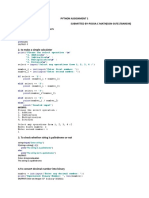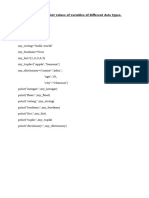0% found this document useful (0 votes)
29 views13 pagesPython Lab A B
The document contains various Python programming exercises covering topics such as Fibonacci sequence checking, solving quadratic equations, summing natural numbers, and displaying multiplication tables. It also includes examples of searching algorithms, calculator functions, string manipulations, sorting algorithms, file operations, regular expressions, data structures like lists and dictionaries, GUI creation with Tkinter, exception handling, and data visualization using Matplotlib. Each section provides code snippets, expected outputs, and explanations for better understanding.
Uploaded by
prashobh1719Copyright
© © All Rights Reserved
We take content rights seriously. If you suspect this is your content, claim it here.
Available Formats
Download as PDF, TXT or read online on Scribd
0% found this document useful (0 votes)
29 views13 pagesPython Lab A B
The document contains various Python programming exercises covering topics such as Fibonacci sequence checking, solving quadratic equations, summing natural numbers, and displaying multiplication tables. It also includes examples of searching algorithms, calculator functions, string manipulations, sorting algorithms, file operations, regular expressions, data structures like lists and dictionaries, GUI creation with Tkinter, exception handling, and data visualization using Matplotlib. Each section provides code snippets, expected outputs, and explanations for better understanding.
Uploaded by
prashobh1719Copyright
© © All Rights Reserved
We take content rights seriously. If you suspect this is your content, claim it here.
Available Formats
Download as PDF, TXT or read online on Scribd
/ 13






















































































